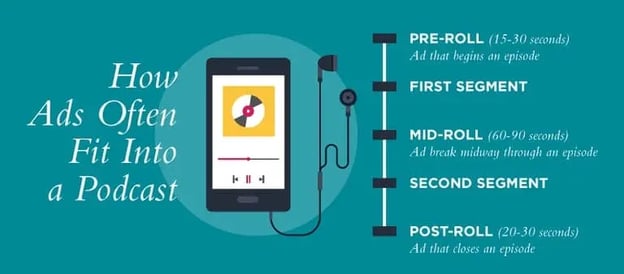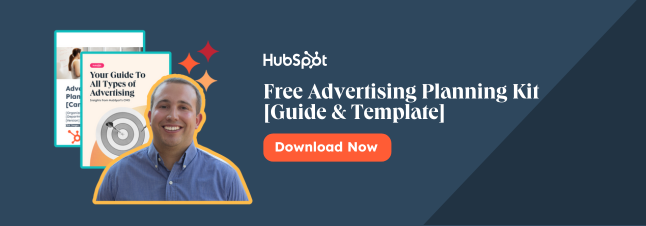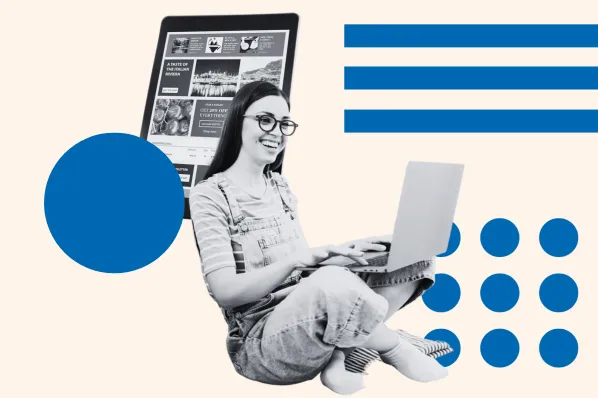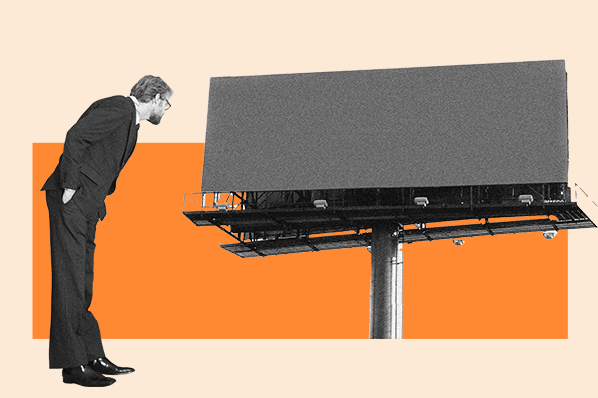According to research by Podcast Insights, there are more than 2 million active podcasts and counting.
.jpg?width=595&height=400&name=podcast-advertising-tips%20%281%29.jpg)
As a marketer for a small to mid-sized business, you might be interested in podcast sponsorship, but not know where to start. Mainly because there are so many podcasts to choose from. How do you know which podcasts your target audience is listening to?

To help you determine what ad strategy is right for you and where to put your podcast dollars, I spoke to HubSpot's podcasting team and did some additional research to comprise a list of helpful strategies for finding, vetting, and advertising on a podcast that aligns with your brand.
Podcast Advertising Terminology
Tips for Finding and Sponsoring Podcasts
Navigating Podcast Sponsorship
Podcast Advertising Terminology
Before we discuss the ins and outs of podcast advertising, let’s review the terminology you need to know before reaching out to podcast hosts and networks.
- CPM Rate: CPM stands for "cost per mille." The CPM represents a flat standard rate advertisers pay for every 1,000 impressions.
- Host-Read Ad: a pre-recorded ad that is voiced by the host(s) of the podcast.
- Dynamic Insertion: the use of software to automatically insert ads into pre-existing podcast audio. These ads can be easily changed across a podcast’s entire catalog without making changes to the original audio file.
- Programmatic Ad: pre-recorded advertisements that do not feature the original host of the podcast. Programmatic ads are typically deployed using dynamic insertion.
- Pre-Roll Ad: an ad placed at the beginning of a podcast episode.
- Mid-Roll Ad: an ad placed near the middle of a podcast episode.
- Post-Roll Ad: an ad placed at the end of a podcast episode.
- CTA: Call to action; unique URLs and discount codes are typically included in podcast CTAs to measure the performance of an ad’s effectiveness on a particular podcast.
- Downloads: how many times a podcast episode has been downloaded from a podcast hosting site. The most common metric to determine the impressions/listens of a podcast.
- Live-Read Ad: an ad that is performed live during a podcast episode, as opposed to being scripted and edited or dynamically inserted into the episode.
Now that you're familiar with the necessary terminology, let's discuss how to find and sponsor podcasts.
12 Tips for Finding and Sponsoring Podcasts
- Consider podcast demographics.
- Understand standard podcast ad pricing.
- Look for podcasts that relate to your brand or industry.
- Use your competitors for inspiration.
- Purchase multiple ads for small shows rather than one for big podcasts.
- Advertise on multiple podcasts within the same network.
- Be vigilant of dishonest podcasters.
- Consider purchasing back catalog space.
- Determine what type of promotion you'd like to run.
- Purchase ad spots online.
- Or, reach out personally to podcasts you'd like to work with.
- Monitor your progress.
1. Consider podcast demographics.
While different types of TV shows might attract different audiences or demographics, the podcast demographics don't change drastically from show to show, according to HubSpot's former Podcast Manager Sam Balter.
Balter explained that the podcast audience demographic, which is generally made up of "affluent educated millennials" is a "good audience for brands pretty much regardless of what show you’re on."
Why is the podcast audience so good? Because of their age, income, and education level, this particular group of people is old enough to make purchasing decisions and has enough income to make those purchases. Because many of them have jobs or are in higher education, these listeners might be interested in learning about a wide range of products or services that make daily life or work easier for them.
According to Alanah Joseph, Senior Marketing Manager on the HubSpot Podcasts team, understanding the listener of the show is key to successful ad placements. She says:
"When reviewing the custom ad placements on HubSpot Podcast Network shows, we define success through more than one lens. We’re looking at the ad from the point of a listener. Does the ad feel like it’s an authentic part of the show? Is it enjoyable to listen to?
From the lens of an advertiser, we’re measuring success by the size of the audience, specifically the number of downloads. Although there are other metrics we’d like to track and report, we’re limited in the data we can collect."
Another great thing about podcast listeners is that they'll tune into podcast episodes for a longer amount of time than they will to other content, like video. The podcast audience also enjoys long-form podcasts that are 30 minutes or longer. Since there's much less drop-off on a podcast compared to other forms of content, like video, this means that ads could be placed towards the beginning or end of an episode and still have a good chance of being heard.
2. Understand standard podcast ad pricing.
The next question you might be asking is, "How much will advertising on a podcast cost?"
If you're new to the podcast advertising world, you might not know how ads are usually prices. You might be worried that all podcast ads might have vastly different prices — or that podcasters will charge a lot for a poor ad slot.
Podcast ad pricing might be more transparent than you think. According to Balter, podcasters and podcast networks commonly use the same formula to determine how much an ad in their podcasts will cost.
If you want to get a ballpark idea of what ad slots for a specific show might cost before reaching out to a podcast team or network, plug the metrics you can find for that show's previous episodes into the formula shown below.
Ad-Sponsorship Formula
Cost of Sponsoring 1 Episode = (# of Downloads per Episode / 1000) X CPM.
As mentioned in the terminology section, CPM stands for "cost per mille," or cost per 1,000 impressions.
Balter says that the cost of a standard ad in a podcast usually costs between $10 and $50 with more popular podcasts also charging a premium.
However, if you want to do a more intensive promotion — such as a full sponsored podcast episode — this cost may vary based on what the content will entail from the podcasters. For example, Gimlet, a prominent podcast network that produces shows like Mastercard's "Fortune Favors the Bold", offers two tiers of advertising: audio ads and branded podcasts.
3. Look for podcasts that relate to your brand or industry.
Because the pool of podcasts is so large, there are plenty of opportunities to connect with niche audiences that relate to your specific industry.
When an ad relates to the topic of a podcast series or episode, it might feel more natural to the listener. It's also strategically smart because listeners who are interested in this industry might identify with pain points that your service aims to solve.
For example, if you place an ad about your B2B recruiting service on a podcast that discusses human resources, listeners who own or manage a B2B company, or human resources employees, might want to use your service to make their jobs easier.
Here's an example outside of the B2B world. On an episode of "The Joe Rogan Experience", a general podcast that zones in on topics like technology, science, and entertainment, Joe Rogan reads a script that talks about how he uses ExpressVPN and Cash App in his daily life. Before going into detail about how he uses these products, he also notes that these companies sponsored the episode.
In the ad, Rogan explains that he uses ExpressVPN to protect his internet data and personal information, while he uses Cash App to pay friends or make transactions on the go from his phone. If you can't listen to the podcast, here's a quick excerpt from the ad:
"With all the recent news about online security breaches, it's very hard not to worry about where your data goes. Making an online purchase or simply accessing your email could put your private information at risk ... That's why I decided to take back my privacy using ExpressVPN. ExpressVPN has easy-to-use apps and runs seamlessly in the background of my computer phone tablet."
Although Rogan notes that he's reading sponsored material before beginning the segment, the services he discusses relate to technology, handy apps, and internet security, which are topics that he has covered on "The Joe Rogan Experience". Additionally, these topics might be interesting to the millennial podcast audience which is highly tuned into smartphone and computer technology.
Lastly, because Rogan describes his own experiences with ExpressVPN, the segment feels less like an ad and more like a friendly recommendation. In fact, listeners who are fans of Rogan might trust that he has used the advertised product and that he had a good experience with it. If they think he's a credible recommendation source, they might choose or consider ExpressVPN when looking for a data security provider.
After an example, you need a brief section that sums up what readers should get from the example. In this case, something like, "One of the main selling points of advertising on a podcast is that listeners are already comfortable with the host. When the host reads your ad copy, there's already a level of trust between the host and the audience that wouldn't be there with alternative mediums like video or display ads. It's almost like a lightweight celebrity endorsement."
4. Use your competitors for inspiration.
As with any new marketing or advertising technique, a competitive analysis can help you identify what similar companies are doing, as well as opportunities where you can get ahead of them.
If you have a direct competitor who has advertised on various podcasts, see if those shows might fit your ad strategy as well. Similarly, if there are brands in your industry that provide non-competing services and use podcast advertising, try to identify shows that they advertise on.
From there, you could either look into contacting these podcast producers or their networks or look for podcasts that have a similar level of success and discuss similar topics. While you shouldn't directly copy what your competitor is doing, a competitive analysis could still inspire you to develop an ad strategy or promotional content that improves upon that of similar brands.
5. Purchase multiple ads for small shows rather than one for big podcasts.
As you start researching podcasts, you might find a long list of shows that will align very well with your product or service. When that happens, do you invest in one expensive ad for the biggest show with the most promising numbers? Or, do you use that money for multiple ads on different podcast episodes?
Balter says, "It’s better to play an ad multiple times on a smaller show than try to a single ad on a big show."
If major podcasts have a huge listenership and ad premiums, you'll have to pay much more for one or two ads that may or may not be memorable. While you might get great visibility, this could be a huge gamble. If the ads don't provide ROI, you'll lose ad dollars.
That's why the safest strategy is to follow Balter's advice and choose frequency over sheer audience reach.
Look at a number of smaller podcasts that still have engaging content and really relate to your product or business. Then invest a bit of your spend in each. If one or two don't pan out well but the others do, consider swapping the low-performing podcasts out with other shows or purchasing more ads on episodes of podcasts that are giving you revenue or brand awareness.
6. Advertise on multiple podcasts within the same network.
If you plan to invest in multiple podcasts — or multiple ads within a podcast episode — and find a network that produces multiple shows that align with your product, consider building a relationship with that network and putting your ad dollars there.
In the podcast world, Balter explains that advertising on shows within the same network is called a "pulsing" strategy, adding that it's better than airing multiple ads on one podcast episode but still can have similar reach.
"Because people who listen to Gimlet shows are likely to listen to other Gimlet shows, you can get a solid number of impressions off of a few shows over a relatively short amount of time without inundating listeners with the same ad over and over again."
Here's an example of a Hendrick's Gin ad that Gimlet has circulated on a number of its podcasts and displayed on its advertising page.
The native ad begins by telling listeners that the episode they're listening to is sponsored by Hendrick's Gin. Then the ad's narrator goes on to discuss the flavors associated with the beverage and how people who drink it are looking to escape from their mundane life.
This Hendrick's ad feels unique but it speaks to a wide variety of people that could be bored with their lives and doesn't note specific industries. The ad also doesn't specify the podcast it's on which makes it easy to place in many different ones.
7. Be vigilant of dishonest podcasters.
As you research various podcasts — especially those that are smaller, you might realize that it's easy to find numbers and success metrics for some, while others are less transparent. Because of this, you'll want to do some extra digging and properly vet the podcasts at the top of your list to make sure they're legitimate.
Balter warns, "Downloads are not algorithmically verified, therefore people sometimes make up how many downloads their show gets. So, if you’re sponsoring a less reputable podcast, make sure to get download numbers for a single episode."
If you want to verify that the podcast is giving accurate numbers before reaching out to them, here are a few steps you can take.
- Look at all the sites they post their podcasts on: If they post on a major site like SoundCloud or Spotify, you should be able to see general platform-provided view numbers to get an idea of how successful their podcast was.
- Look for them on social media: While podcasters might not be airing episodes on social media, they might have a following or a few social accounts to spread awareness of the show. If they do, look at the follower count, likes, and visual signs of engagement on these pages. If you can find signs of social engagement and a following, this might be a sign that they have a legitimate audience.
- Work with a credible network: Many credible networks might be transparent about podcast numbers to potential and current advertisers. Additionally, you can look at the success of the network's other shows as evidence that they're associated with engaging content.
When you do finally talk to the podcast producers, get as much specific data as possible about views and impressions. If they have or have had advertisers in the past, you might want to ask them if their advertisers have seen an ROI. If they can show proof that advertisers make more money than they spend on ad slots, this shows that ads on this podcast can be successful.
8. Consider purchasing back catalog space.
A back catalog is a collection of a podcast's previously recorded episodes. Back catalog podcast episodes might still be listened to, shared quite regularly by listeners, and up for grabs when it comes to ad space.
Because back catalog episodes have already aired and don't seem like an obvious ad opportunity, Balter says this tactic is "interesting and something a lot of people don’t consider."
If you do decide to advertise in back catalog podcasts, zone specifically into evergreen episodes that will continue to remain relevant for a longer period of time.
For example, if you're a marketer for an e-commerce home-shopping site, you could advertise in back catalog podcasts about DIY ideas or home decorating. This type of podcast won't age drastically over time and might be relevant to anyone listening to podcasts about those topics.
While these podcasts might've already been promoted during their first launch, podcasters are often encouraged to re-promote evergreen back catalog content. Your brand could also share the podcast on your company's social channels for some added promotion.
9. Determine what type of promotion you'd like to run.
While some companies like to create standard native ads that exist as pre-roll or mid-roll within a podcast episode, other brands might pay the podcast producers to create sponsored content.
Similarly, advertisers might want to script the ad and have the host read it, or have the host casually work product discussion into the podcast conversation, so it feels more natural. Some podcasts may only offer certain types of sponsorship options, but if you still want to consider the different types, here are a few with an example for each:
Native Ad:
A native ad is created by the brand for the podcast. With this common strategy, you'll create a short audio clip that discusses your product, service, or another promotion related to your brand. These usually run for 30 seconds or less and sound a lot like audio ads you'd hear on traditional radio stations. These ads usually air as pre-roll or mid-roll ads after a podcast host says something like, "And now, a word from our sponsors."
Below is an example of an ad for the Toyota RAV4. In the 30-second ad, a narrator describes all the unique features that make the car safe, reliable, and fast. Like the Hendrick's Gin ad noted above, the ad doesn't acknowledge a specific podcast so it can be shared on multiple different shows.
If you're looking for inspiration for a quirkier native ad, check out GEICO's list of ads, which have been aired on both radio and podcasts.
Sponsored Content:
With sponsored content or branded podcasts, you pay the podcast production team to create interesting content about a topic related to your industry of the company.
While the content might not discuss your product outright, the podcast hosts will note that your brand sponsored the podcast — and most likely include some information about your product or service.
If the podcast is valuable and interesting to the listener, they might remember your brand and affiliate informative content with your company.
One recent example was a mini-series called "The Sauce" in 2018. The podcast, sponsored by McDonald's — and created by Gizmodo and Onion Labs — investigated why people rioted over the removal of Szechuan Sauce from the McDonald's menu. While the podcast has since been removed from Apple podcasts, you can find a short preview for it on Gizmodo's Facebook page.
Paid Interview:
This is a type of sponsored content where an expert from or affiliated with an advertising brand is interviewed in exchange for the sponsorship dollars. While this gives your company's experts an opportunity to spread brand awareness and show their expertise, it also allows the podcast to create interesting interview content about a topic related to its own mission.
In the example below, Daymond John interviews a rep from ZipRecruiter, on the podcast, "Rise and Grind." Because the podcast series regularly discussed business, entrepreneurship, and management, this ZipRecruiter-sponsored interview about hiring talent, still feels like a natural piece of content.
This paid interview tactic could also work for businesses in other industries as well. For example, if you're a marketer for a cookbook publisher, you could pay for a chef who created some of a new book's recipes to get interviewed on a podcast related to cooking, home-making, or DIY.
In another example, if your company sells medical devices, you could pay for your CEO or an executive to be interviewed on a podcast that touches on medical news or technological advances.
In either example, audiences who listen to those podcasts because they want to learn more about topics or products within their industry might hear the interviews, gain insight from the experts, and trust your brand more.
Product Placement:
This is a form of sponsored content where podcasters are paid to mention your product casually in the podcast's discussion.
In a classic example, the "My Brother, My Brother, and Me" podcast aired an episode about Totinos which was sponsored by Totinos.
While the hosts played games and had random discussions about life, as they've done in most of their episodes, they were chewing Totino's pizza rolls most of the time and made each game or featured piece of content center around the food product.
Direct Response Ads
This is a native ad that feels like a product placement where the host reads a short script written by the advertiser. The ad ends with the host telling listeners to do something, such as click a link or use a coupon code. Unlike the more traditional pre-roll or mid-roll native ad, the listener is still immersed in the experience of listening to the host.
Although the host notes that their discussion is sponsored, it still might make the listener feel like they are getting a solid recommendation from the host.
On Dax Shepard's podcast, "The Armchair Expert," he includes at least one direct response ad in the middle of each episode. At the 65:00 mark of this episode, Shepard reads a script that explains the benefits of using the meal-delivery service DoorDash. Then, he tells listeners to download DoorDash and use the code "DAX" to get $5 off of their first order:
10. Purchase ad spots online.
If you're just looking to purchase a standard ad slot and already have an audio clip, some tools allow you to purchase space and target ads to appear on multiple podcasts.
For example, if you're just planning to target one or two simple native ads to millennials on Spotify, you might want to use Spotify Ad Studio to create and launch basic native ads on the music platform. If you want to launch to multiple host-read ads in a number of different podcasts, you could consider using a service like Midroll, where you can submit ad information and purchase ad slots in a variety of different podcasts.
11. Or, reach out personally to podcasts you'd like to work with.
If you want to do something that requires more planning, like sponsored content, a paid interview, or preparing scripted product placements, you should make an in-person connection with podcasters.
"By being intentional when looking for creators, we can create a truly collaborative environment and allow creators to infuse their personality and voice into our ads," says Joseph.
Once you've done your research and found a few podcasts you're interested in, reach out to begin discussing your advertising options. Send an email with a little bit about your brand and why you think you could work well with them as an advertiser. Be sure to also ask about their growth and key success metrics to confirm that they are as promising as you think.
Need help reaching out to potential podcast hosts or networks you’d like to sponsor? Check out the template below.

Once you find the podcasters you'd like to partner with, keeping them involved in the creative process is key. Avoid handing them a dry script to read verbatim. "I've learned the more we allow our podcasters to participate in the creation of the ad, the better the ad will be," Joseph says.
12. Monitor your progress.
Regardless of what type of promotion you purchase, you should be tracking your money spent compared to the money the advertisement earned. This will help you determine the ROI of your campaigns.
If you're publishing promotions on multiple podcasts, this will be an important way to tell which might warrant more advertisements and which might require less to no ad spend.
With this post on marketing ROI, you can learn how to use a simple formula to calculate and find a few examples of how it can be used when strategizing in the real world.
How to Advertise on Podcasts
Ready to launch your advertising campaign on relevant podcasts? Here’s what you should consider.
1. Determine the type of ad you want to run.
As we reviewed above in the podcast terminology section, there are a few different types of podcast ads to consider. The right type of podcast ad for you will depend on your budget and the goals of your campaign.
Host-read ads tend to cost more than programmatic ads, however, according to Nielsen host-read ads are more effective because hosts have already established trust and recognition with their audiences.
2. Select the best ad placement for your campaign.
Additionally, ad placement and length matter. Though the first few minutes of a podcast reaches the widest audience, pre-roll ads, or ads that play at the beginning of a podcast episode, tend to have a lower CPM rate because users can easily skip over the ad.

On the other hand, mid-roll ad placements tend to have a higher CPM rate because listeners who reach the middle of an episode tend to be more engaged and likely to follow a CTA. In terms of length, 30-second ad placements have an average CPM of $18, while 60-second ad placements have an average CPM of $25.
3. How to write a podcast ad.
Now that you know what type of ad you want to run and have determined the placement, it’s time to tackle the messaging. Whether you are doing host-read or programmatic ads, the on-air talent needs talking points from you to ensure the ad shares information that is relevant to your campaign.
Here are the elements to include when writing a podcast ad script.
Hook the Listener
Begin with a bold or attention-grabbing statement to get the listener’s attention and reduce the likelihood of them fast-forwarding through the ad.
Personal Story
Once the audience is hooked on the ad, the on-air talent should introduce the product and share a quick personal story outlining why they enjoy the product. A simple way to do this is to mention what problem they were experiencing, how they were introduced to the product, and the positive results or solutions they experienced after using the product.
Call to Action
Close the ad by creating a clear call-to-action (CTA) for the listener. A popular CTA used in podcast advertising is special codes and unique URLs specifically for that show. These are easy for the audience to remember because they are typically related to the name of the podcast, and can be easily measured for KPI tracking.
4. How to create a podcast ad.
Once the script has been finalized, share it with the on-air talent so they can record the ad as a standalone mp3 file. During the post-production process, the ad should be placed in the episode audio file during the designated placement time. If using dynamic insertion technology, upload the mp3 file to the podcast hosting software so it can be automatically played during the episode.
Navigating Podcast Sponsorship
The podcast landscape is a pool of growing opportunities for marketers. And, if you're ready to start testing the sponsorship waters, be sure to keep these key tips in mind.
- Find podcasts that align with your brand: People are listening to an episode to get informed about a specific topic. If your ad aligns well with it, they might be interested in learning more about your product.
- Choose frequency over audience reach: It's less risky and more efficient to invest in multiple ads on smaller podcasts rather than just one or two ads on a major podcast.
- Consider working with a network: Networks may provide more legitimate view numbers and have a variety of podcasts with similar audiences that you can air your ads on.
With the right strategy in place, you can get your product in front of an engaged community of potential buyers through podcast advertising.



![How to Make an Ad: A 15-Step Guide [+Expert Tips]](https://blog.hubspot.com/hubfs/how to make an ad.png)

![How Consumers Responded to Black Friday in 2022 [+ Holiday Marketing Tips]](https://blog.hubspot.com/hubfs/black-friday-ads_0.webp)
![What is Comparative Advertising? [+ Examples]](https://blog.hubspot.com/hubfs/Untitled design-Aug-17-2022-02-39-51-39-PM.png)
![How to Prepare an Advertising Plan [Free Template]](https://blog.hubspot.com/hubfs/advertising plan example.jpg)
.jpg)
.jpg)
